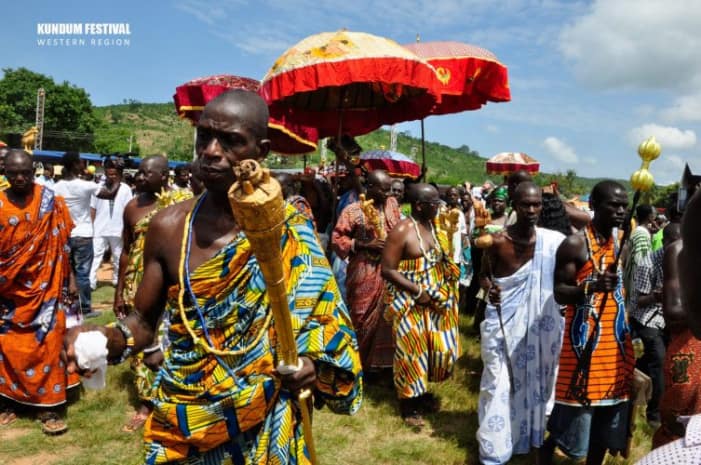What Kundum is
Kundum is the signature festival of the Ahanta and Nzema peoples. It blends harvest thanksgiving with religious purification, marking the end of the farming season and ritually “sweeping out” misfortune to make way for prosperity.
Origins & meaning
Oral tradition traces Kundum to a hunter, Akpoley, who witnessed dwarfs dancing in the forest; he carried the dance home and it became the core of Kundum rites. Historically, the festival is documented by 17th-century Dutch writer Willem Bosman. Today it’s widely understood as both a “harvest dance” and a rite to drive away evil.
When and where it happens
Kundum moves town by town across the Ahanta–Nzema coast (Sekondi–Takoradi to Half-Assini) from late July/August through November. Typical anchors often include:
- Lower Dixcove: July–August
- Axim: 2nd week of September
- Busua (Ahanta): October–November
Each town schedules its own start Sunday.
How Kundum unfolds (classic structure)
Traditionally the celebration spans four weeks (some towns now compress to about a week). The pattern below captures the classic flow:
- Weeks 1–3 (night rites on the outskirts) — Drumming and dancing take place after dark at the Siedu/Sienu sites outside town. Drums are carried to five shrines where libations (often rum) are poured and petitions made for communal well-being. Attire is distinctive and may include special footwear and masks.
- Week 4 (public climax)
- Monday: quiet—no drumming or dancing.
- Kundum fire is lit at the chief’s palace and kept burning; it becomes the center for communal cooking.
- Tuesday: private sacrifices (fowl/sheep) in the stool room (where ancestral stools are kept), followed by a public sacrifice in the courtyard. Singing begins.
- Wednesday: the chief appears, often in palanquin, to join processions amid singing, drumming and dancing.
- Final days: nightly communal meals led by elder women; a grand feast on the ultimate Sunday; concluding dances (in Axim, often before the castle). The ritual intent is to expel evil and secure the next successful year.
Many communities now compress these phases into about eight days, but they preserve the key rites—drumming/dance, stool-room sacrifices, procession, communal feast, and the purification dances.
Signature performance: Avudwene songs
A hallmark of Nzema-Ahanta Kundum is Avudwene—satirical performance songs that publicly critique social behavior and leadership, acting as a ritualized civic check. Scholarly work documents Avudwene’s role and its timing at Kundum’s climax in multiple Nzema towns.
Symbols & practices you’ll notice
- The dance: circular, call-and-response patterns echo the Akpoley legend and the dance’s protective power.
- Kundum fire & food: continuous flame for communal cooking—women, guided by elder women, prepare the shared meals.
- Shrine circuits & libations: drum visits to shrines frame the festival as a covenant with ancestors and local deities.
- Regalia & procession: parasols, palanquins, umbrellas, state swords, and sometimes masks; chiefs and elders lead.
Contemporary shape
While rooted in agrarian cycles, Kundum today also features durbars, speeches, development appeals, tourism events, and broader participation (diaspora visitors, state officials). Town calendars remain staggered, allowing people to attend multiple Kundum weeks across the coast.
Why Kundum matters
- Cultural continuity: links present-day Ahanta–Nzema communities to ancestral institutions (stools, shrines, dance).
- Social critique & renewal: Avudwene empowers communities to voice truths in a sanctioned setting.
- Economic & civic value: attracts visitors and focuses attention on local development needs.
Quick FAQ
Is Kundum the same everywhere?
No. Each town runs its own program and dates, but core rites recur—drumming/dance, shrine visits, Kundum fire, stool-room sacrifices, procession, communal feasts, and closing dances.
When should I go?
The season rolls from late July/August to November. Axim’s high-profile week often falls in mid-September; Dixcove and Busua anchor earlier and later ends of the run. Check the current year’s local notices.
What’s unique to Kundum?
The Akpoley origin story, Kundum fire, and the Avudwene satirical tradition are distinctive features.
DISCLAIMER: The Views, Comments, Opinions, Contributions and Statements made by Readers and Contributors on this platform do not necessarily represent the views or policy of ahantawest.com

